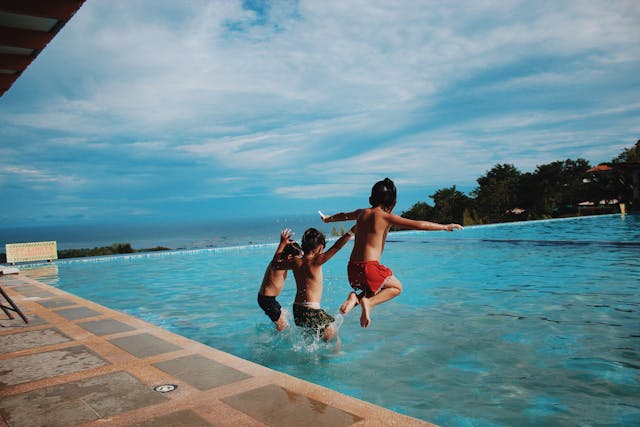Ready to jump in with some swimming safety tips? Not even Coronavirus can stop us from taking a dip with family and close friends.
In these uncertain times, you want to include stress relieving activities. As an exercise that works out your whole body, swimming can be a great one!
When swimming this summer, take the necessary safety precautions no matter what your age.
Swim buddy system. The buddy system is important so you can look out for each other while in the water. If someone starts to feel sick or loses control while swimming, his or her buddy can call out for help. If your buddy knows CPR, all the better!
Take frequent breaks. Swimming takes a lot of energy and muscle power. It’s a full cardio workout, which means your heart and lungs are giving it their all. If you start to feel tired and like you can’t keep up, sit this one out. Just a few minutes of rest may be all you need before you’re back in line at the diving board.
Be on your guard. (Lifeguard, that is.) Lifeguards are trained to keep people of all ages and sizes safe in the water. They are required to take water safety courses and undergo CPR training. If you’re at a pool or lake, the best way to keep your family safe is to look for a life guard before heading in together for a dip.
Take a lesson. Investing in swim lessons is one of the best gifts to give your kids or even yourself if you missed the swimming boat as a youth. Anyone at any age or skill level can learn to swim. Once your child masters being able to tread water and swim in the deep end, you’ll feel so much more at ease while at pools, lakes and beaches.
You’ll also open the door to all sorts of fun, warm-weather activities such as boating, kayaking, wave running and more. Knowing how to swim, and doing it well, will assure a safer and more enjoyable summer for everyone!
Watch out for kids. Never leave children to swim unattended. No matter how strong a swimmer your child may be, you should never leave him or her unattended in the pool, at the lake and especially not while swimming in the ocean. Station your group in close proximity to a life guard, and put an adult in charge of overseeing the swimming activities just in case.
Floaties are your friend. When in doubt, grab a floatation device. Kids’ life jackets, water wings and pool floaties should be worn according to age and size. Adults too, should check the maximum weight capacity on their floatation device of choice. No shame in taking a rest on your pool raft if you feel the need.
Find your safe zone. Observe the water depth. Teach kids to be mindful of the number printed on the side of the pool. Teach them early so they’ll know that “3 feet is the safe zone,” but 5 is the deep end where only the expert swimmers can go. Even if the deep end’s been roped off, it’s still better to make children aware of water depth just in case.
Obey the rules while at the pool. Mind the rules of diving and swimming. Teach your children that the adults who are in charge of the pool should be respected. If the sign says NO DIVING, NO RUNNING, NO HORSEPLAY then follow accordingly. If kids can’t read yet, take a moment to explain. The rules of the pool are there to ensure the safety of all.
Sunscreen it up. Keep sun exposure to a minimum. Vitamin D is definitely important, so a little sunshine is okay. But if you plan to be out for several hours, be sure to apply a good, waterproof sun block. Brimmed hats, awnings, umbrella and beach cover ups are other, less messy ways to stay shielded from those UV rays.
Eat, then rest. Take a rest after eating before you get in the pool. Some say that you should wait at least a half hour before heading in to take a dip after eating. You don’t have to follow this rule to a tee, but it’s good practice to “rest while you digest” so you won’t end up overexerting in the water.
Play it safe. Keep water horseplay to a minimum. If someone seems scared or uncomfortable, let them be but stand by in case they may need help or maybe even some water safety tips. Teach kids to respect the space of other people. Of course, some splashing and frolicking is great provided everybody’s enjoying it. But if there’s an uncertain swimmer in your midst, or someone who’s afraid of the water, be mindful of their feelings and of course their safety.
Need Web Content? Outsource to a Great Copywriter, Stat.
Dina works from home as a freelance copywriter, content writer, marketing consultant and virtual assistant. Email info@healthyhappynj.com for a project quote today.
